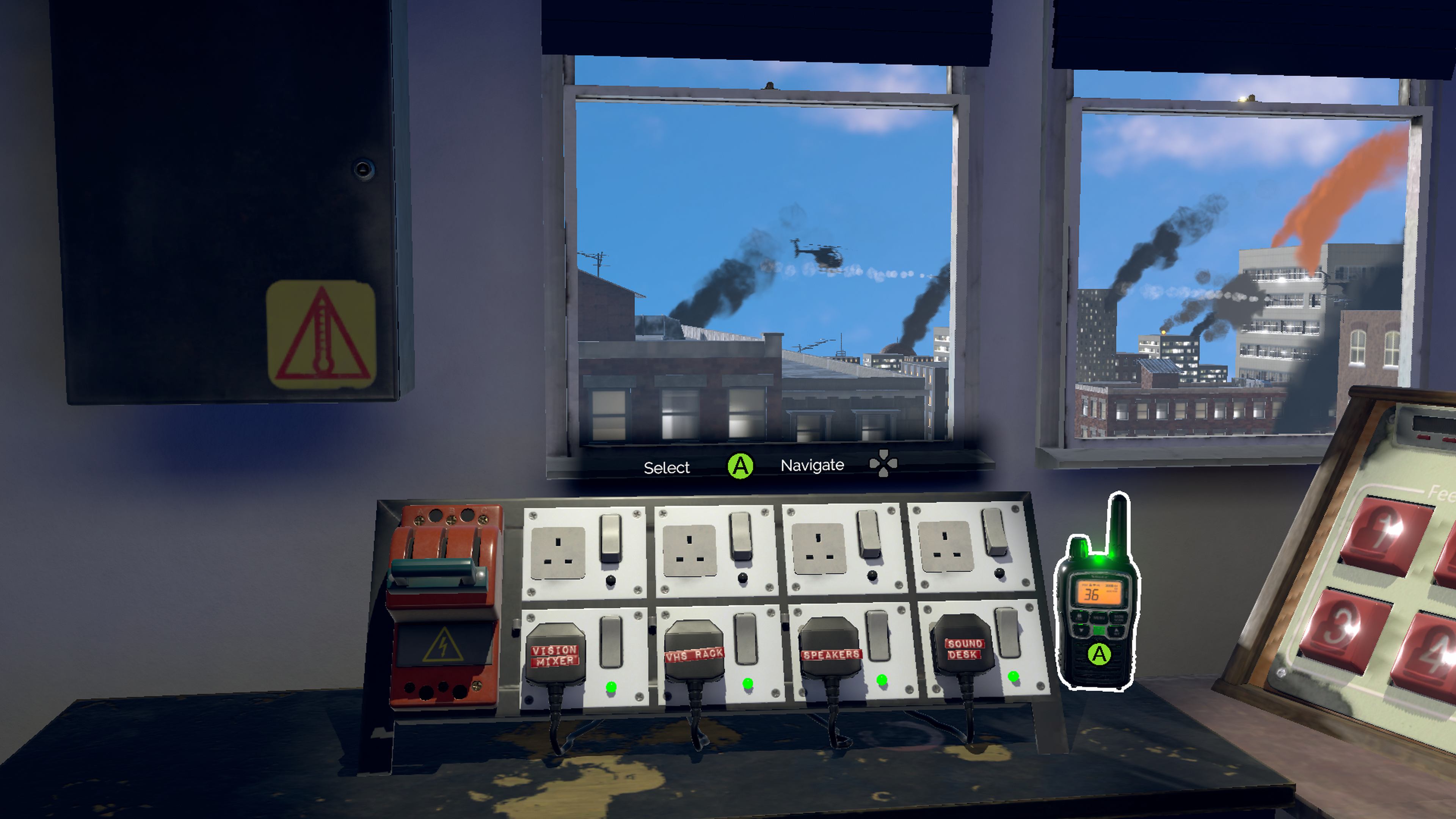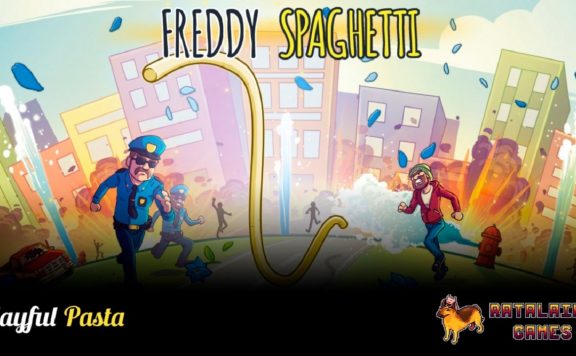Every so often I get to experience a game that is unlike anything I’ve played before. So many games released nowadays are derivative in one way or another. However, that is not the case with Not For Broadcast, a satirical adventure/simulation developed by NotGames and published by tinyBuild. Most of the gameplay involves the player acting as a live TV editor. NotGames have struck gold here by creating a realistic, yet easy-to-use interface for interacting with the game. NotGames have also woven an engaging story that develops throughout multiple in-game years. If you can’t tell, I thoroughly enjoyed Not For Broadcast; I think it has a mass appeal due to the novelty value alone, but if you’d like to find out exactly what pulled me in then stay tuned for the full review after this short break.
I should probably start by saying that I don’t play many FMV adventure games. Obviously, Not For Broadcast isn’t your typical FMV-style adventure game, but it does feature a live-action story. You play as Alex, who has just taken over fom the previous nightly news editor. This interaction with your predecessor is the start of a whirlwind story that stretches over years of in-game time. You might wonder how the developers can tell a cohesive story over such a long period of time. The main plot in Not For Broadcast revolves around the changes occurring in a fictional country after an authoritarian party takes over in the elections – you broadcast the victory speeches on your first night on the job. As a news editor, you have a great deal of power in your hands. You can decide how the newly elected officials as well as their counterparts are perceived. The story echoes many elements of real life, from politics to entertainment, and even a subplot about a lockdown, poking fun at each part many times along the way. I don’t know how the game will age, but I think it is very topical for the current climate and I found myself smiling many times while playing.

The majority of the game takes place in an editing room where you have a first-person view of all the equipment necessary to edit and produce a broadcast. This user interface layout gives you a large amount of control over each night’s broadcast. At first glance, it might be intimidating, but the game does a fantastic job of introducing you to the different mechanics, with the former editor walking you through the basics over a speakerphone sitting on a table to your right.
The basics start with you turning on a power board to your left. You must then sort through a selection of VHS advertisement tapes under your desk and select the three you will play during the broadcast by inserting them into a trio of VCR slots. These actions need to be taken at the start of each day in the studio, but after that, you get to the bread and butter of the game. In front of you are six screens. Four small screens on the left are the different feeds coming into the editing room. There are two larger screens to the right which are the live feed screen and broadcast screens (the broadcast screen is delayed roughly 2 seconds). The first mechanic you learn is how to switch between the four cameras. You have four choices, each labeled with one of the four face buttons on the controller. The left trigger activates the bright red dump button on your control panel, allowing you to censor any audio you deem offensive; keep in mind that you have to censor it on the screen with the two-second delay. Luckily the game gives you an audio cue when something should or could be censored and the outgoing sound is even displayed on a tiny screen with the bleepable audio appearing in a different color. The third mechanic introduced in the opening section is interference. On the right side of the control panel is a grid-marked screen with a wavelength stretching across. At certain points during the broadcast, due to shoddy equipment, you have to adjust the wavelength with the right joystick to prevent interference such as distortion and static from contaminating the airwaves. This trio along with the intro and outro responsibilities feels like a great starting point.
As you progress there are several additional mechanics thrown into the mix, some just for one broadcast but most of the others must be picked up rather quickly as they become part of the game’s nightly repertoire. The added mechanics range from what you might expect to find on an editing board to the somewhat absurd. There is a set of audience reaction buttons, allowing you to add sound bites such as applause and laughter. While filming a broadcast during a heatwave you have to take control of a swivel fan, pointing it at whichever server is overheating at the moment.
The typical broadcast is split into three sections, each of which lasts anywhere from five to ten-plus minutes. I lost count of the number of broadcasts you play through. I’m actually amazed at the amount of content for this game. The story can veer off in a number of directions based on the decisions you make on and off the air and I’ve heard there are fourteen different endings, which is rather impressive. Another impressive aspect is the save system; each broadcast and every segment within that you’ve played has a save point that you could go back to if you wish. When doing this the game gives you the option to start a new save file, which seems like it could save plenty of time for any completionists out there. Overall though, I have mixed feelings about the game’s replay value, as once you’ve played each broadcast you’ve seen the majority of the content. There are some segments that I would imagine must be drastically different depending on your choices, but for the most part, the only variation is how you choose to edit, and possibly the difficulty setting you have chosen. Not For Broadcast features five traditional difficulty settings ranging from story mode, which is described as particularly easy all the way up to extremely difficult. There is even a custom difficulty setting allowing you to crank the difficulty sliders to the max, turning on all the challenges.

The one aspect of the game that falters is the choose-your-own-adventure style interludes between broadcasts. For the most part, these focus on your life outside the job, such as choices surrounding your family. Some of these interludes represent gaps of over a year in the story’s timeline and they just don’t give enough exposition, making me lose immersion in the game. During my one full playthrough, these sections seemed as if they were the main factors in steering the story, but the broadcasts are so much more interesting and engaging. Don’t get me wrong, your editing choices have consequences too, but the text-based interludes seemed to drag down the story as a whole.
The developers have structured the core gameplay in such a way that it will be very easy to add additional story chapters to the game. In fact, they have already released one such DLC, “Live and Spooky”, which is a spoof on a paranormal investigation show, and having played the first chapter I can say that it’s a perfect addition to the in-game universe. Just like the main game, your editing choices will determine the outcome of the story. They have two other DLCs in the works as well, both of which I’m greatly anticipating.
Conclusion
Not For Broadcast is unlike anything I’ve played before. The tv-editing simulator gameplay presses all the right buttons, keeping you engaged in a well-written story packed with humor. The writing really clicks with many elements, riffing on real-world events over the past few years. I don’t know how well the story will age, but the gameplay is so unique that I have no doubt it will stand the test of time. I give Not For Broadcast my full recommendation. I know some of the games I get behind can be somewhat niche and might not be for everyone, but I really believe Not For Broadcast has mass appeal, scoring high in all demographics.
This game was reviewed based on Xbox S|X review code, using an Xbox S|X console. All of the opinions and insights here are subject to that version. Game provided by publisher.




